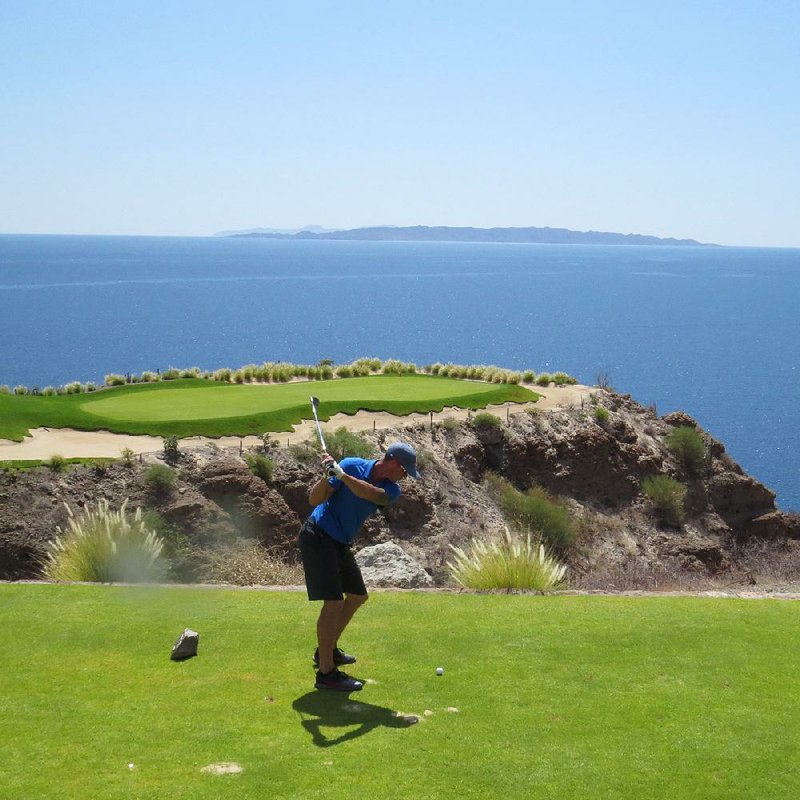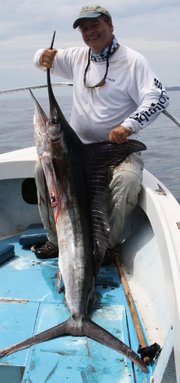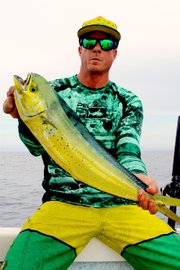LORETO, Mexico -- If I never catch another fish, I'll retire satisfied after last week's outing on the Sea of Cortez.
And that's a bald-faced lie. I am addicted!
The occasion was a media outing at Villa del Palmar at the Islands of Loreto, a plush resort nestled among the stark, rocky spires of Baja Sur, near Loreto. The Villa Group invited a group of fishing writers, bloggers and broadcasters to experience the incomparable fishing in the area by way of its "Islands of Loreto Fishing and Golf Tournament."
The two-day tournament targeted only black marlin, blue marlin and dorado, the latter being known as dolphinfish or mahi-mahi. The team that caught the biggest marlin won a free entry into a bigger tournament of its choice in the fall originating from Cabo San Lucas or East Cape. The team weighing in the biggest dorado won $10,000. An eligible dorado had to weigh at least 12 pounds.
To our surprise, a media group competed each day. The first day's media team included Jim Hendricks of Long Beach, Calif., a staff writer for Sport Fishing magazine; his son Brandon Hendricks of Long Beach; and Sid Dobrin of Gainesville, Fla., proprietor of a multimedia enterprise called Inventive Fishing. Dobrin is also a writing professor at the University of Florida. Rounding out the group was another Hendricks who covers outdoors for the Arkansas Democrat-Gazette.
While the other teams went to sea in gleaming, powerful fishing craft, we were assigned to a 21-foot panga skippered by an affable fellow named Humberto.
A panga is a narrow but stable boat with a sharp, upswept bow and a low stern. Humberto's panga has a metal tower over the console that is not actually bolted to the deck. Its fuel tank has no cap, and it is powered by a tired, oil-thirsty 115-hp Yamaha four-stroke outboard.
The tournament started in the wake of a storm. As we left the sheltered marina, we entered a rolling expanse of high whitecaps.
Crawling up the swells, Humberto let off the throttle on the crests and crashed into the troughs. It took us nearly two hours to go about 16 miles to the tip of Isla Carmen.
About midway there, the motor groaned.
"Oil," Humberto grunted as he killed the engine.
With the boat heaving and pitching, Humberto removed the cowling and straddled the engine like a bullrider. He poured in a quart of Quaker State, and we all crossed our fingers as he turned the ignition.
He had to feed it another quart on the return trip, and then dove into the water to retrieve the oil cap. The meter, if it was accurate, said the motor had logged 4,800 hours.
Jim Hendricks noticed birds diving on the water and speculated that dorado were probably beneath them.
We weren't set up to catch dorado or anything else, really. Humberto's tackle was very basic and worn. Our only bait was live Spanish mackerel.
Fortunately, the California Hendrickses brought two of their own rigs. They were light Okuma Nomad three-piece travel rods and Okuma Andros 52A two-speed reels with lever drags.
"It's got a double disc drag that applies pressure from both ends so you can land big fish," Brandon Hendricks said.
The line was blue, 65-pound test Yo-Zuri Superbraid with 50-pound test Yo-Zuri TopKnot flourocarbon. The hooks were Owner 3/0 circle hooks.
Jim Hendricks's hunch about the birds was correct, but the dorado were too small too take whole mackerel. Instead, we trolled flank strips. Brandon caught one, and the entire school followed it to the boat.
"Muchas dorados!" Humberto shouted as 40-50 of the brilliantly colored fish swarmed at the side of the boat.
"We need a couple of spinning rods with bucktail jigs," Brandon said. "That would keep them interested, and we could load up."
Instead, we caught eight small dorado, up to about 8 pounds, in singles and doubles.
The sea gradually calmed until it was glassy and slick. It was the brightest, deepest shade of blue. In the distance, the rock walls of the Baja escarpment glowed in shades of cream and buff.
As we trolled, Jim Hendricks spied the scythe-shaped tail of a marlin poking through the water. We crept closer and saw there were two.
"We caught them napping," Jim Hendricks said. "Quick, get some mackerel ready!"
Marlins often "sleep" at the surface, Jim said, but "sleepers" are the hardest to catch.
"It's kind of like somebody shaking you awake and poking a cheeseburger in your face," Brandon Hendricks said. "You're not really interested in eating at that moment."
They were striped marlins. They sounded as we passed, but in such clear water, they shimmered and glowed like plasma nebula balls. I was awestruck and transfixed.
Brandon Hendricks pitched a mackerel into the wake and let out line. It was free for only a few seconds when a marlin slammed it and tore away like a dragster.
Brandon engaged the reel and adjusted the drag. His rod bowed, but the 40-pound leader snapped quickly.
I am eternally grateful for what Brandon and Jim did next. With the fishing so slow, it would have been understandable for Brandon to take another swing, or for Jim to have a go. They owned the rods, after all.
Instead, Brandon hooked another mackerel and said, "Mine broke off. You're up!"
As quickly as before, a marlin grabbed it and hit the afterburners. Chaos ensued as Brandon yelled for me to put the reel in gear. He and Jim yelled for me to get the rod out of the holder, which was very difficult because the marlin had it wedged in the tube.
With everybody yelling, I managed to free the rod from the holder.
Without a fighting harness, I wedged the rod against my left forearm and held on tight.
The reel sizzled as the marlin made a series of long runs. My right arm twirled the reel handle like Pete Townshend thrashing a guitar as I struggled to keep pace. I tripped over feet, camera boxes, fish bags and assorted gear as Brandon and Jim shoved me to the bow. Humberto deftly maneuvered the boat to keep the fish in front.
Finally, the marlin did a shimmying, Jackson-esque moonwalk across the surface.
Words can't describe the power of that fish or its airborne majesty. I'd dreamed about it, but to actually live it was otherworldly.
Feeling the marlin's resoluteness ebb, I sensed an advantage and applied the heat.
"Ven a Papa![Come to Papa]" I yelled.
Delighted, Humberto repeated it in a bellowing laugh as he clasped my shoulders. He yelled some other things I didn't understand, and yet I understood him perfectly because the language of fishing is universal.
The marlin continued tailwalking a few yards from the boat and then dove deep. Brandon coached me to reel down to the fish slowly and fluidly to avoid slacking the line.
When I finally coaxed the marlin to the side of the boat, all five of us leaned over the gunwale and nearly capsized the panga.
Then, the marlin went on the offensive. Jim Hendricks was shooting photos when he saw the marlin's bill streaking into his lens. He sidestepped as the fish crashed onto the deck, but the marlin tail-whipped his legs purple. And then it raked its bill across Dobrin's leg.
Humberto put an end to the battle by severing the marlin's spine with a knife.
The fishing was done, but our afterglow was as bright as the Baja sun. Never has beer tasted sweeter or colder, nor has laughter been so genuine.
Brandon Hendricks' generosity made it possible, along with his and Jim's coaching and Humberto's helmsmanship. It was a team effort, and it gave us considerable satisfaction to land one of only two marlin caught in the entire tournament, even if our species was ineligible. In the least likely of boats to catch a marlin, no less.
It meant just as much to earn the approval of such fine, accomplished anglers.
I now see why people get consumed with marlin fishing. I can't get it out of my mind.
Sports on 08/06/2017



